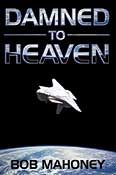| 1st
World Library
Break
|

Author's Preface A few months before the first space shuttle launch in 1981, I wrote a story for my high school creative writing class with the same title as this novel. The plot was a space shuttle version of the now-familiar premise pioneered in 1964 by Martin Caidin in Marooned—a race by Mission Control to rescue a crew trapped in space. The precipitating crisis in my story? The explosion of a propulsion system. The particular shuttle I stranded? Challenger.Jump ahead to 1997. After serving as a spaceflight instructor at the Johnson Space Center for nearly ten years (which I still consider the coolest job in the world), I felt a calling to another purpose and profession: writing. I hoped to explain technical aspects of real spaceflight while conveying its still-potent exhilaration to a seemingly disenchanted public. Since a good portion of my duties in Houston had me crafting off-nominal training scenarios for astronauts and flight controllers, my original story premise inevitably came to mind. I had learned in the intervening years, however, just how difficult (for the sake of fiction) stranding a shuttle in space could be—with so many redundant systems, most realistic failures would only shorten a mission, not prevent reentry. But I devised a plausible way. For five years I typed away in the nooks and crannies of my days, reweaving story particulars when current events swept past my near-future assumptions. Late into the night of January 31, 2003, I was plugging through what I hoped would be my final line-by-line edit. About 60% through the draft, I happened to be fine-tuning a chapter detailing the dire peril of the stranded astronaut crew if they tried reentry with their shuttle—a shuttle that had suffered left-side damage to a vital portion of its thermal protection system. The next morning some of my former students perished in the sky less than 300 miles from my home. Beyond my grief and shock I felt nauseous. While I wasn't close to any of the Columbia crew, I do have some brief but bright memories of classes and briefings with some of them. Many of my friends worked with these crewmembers daily, however, and I appreciate how difficult this tragedy has been for them. In that light, I had a difficult decision to make. Should I proceed with my novel, aware that a story containing so many parallels to the recent tragedy might further wound my friends and the families of those lost? Could post-accident publication be viewed as anything but exploitation of a national tragedy? I spent weeks unsure what to do. Eventually, after hearing often in that time that space exploration would and should go on, I recognized two important points. First, the in-flight breakups of Challenger and Columbia occurred so quickly that, once begun, the flight control teams had no chance to intervene. This shades the grief of those in mission operations with an extra wistfulness, because so much of the mission ops culture is to prepare for, to be fine-tuned for, real-time response to a crisis. While the investigations following both tragedies cited errors in judgement at the management level, the 'folks on the floor' never had the opportunity to prove their mettle against a life-threatening in-orbit emergency. From its inception, this story celebrated that untapped readiness, and my ten-year immersion in the culture at Johnson Space Center had reinforced my conviction to share that preparedness with the general public through the medium of exciting fiction. Second, my determination to reawaken that public, especially the young, to the exhilaration of real spaceflight for its own sake has never wavered. Although fiction, this story builds on real activities of the space operations team as they go about their duties performing the coolest jobs in the world. This story, in its heart, is for them. Bob Mahoney
Authors serving authors ... All
material on this site Copyright © 2006 Groundbreaking Press |
